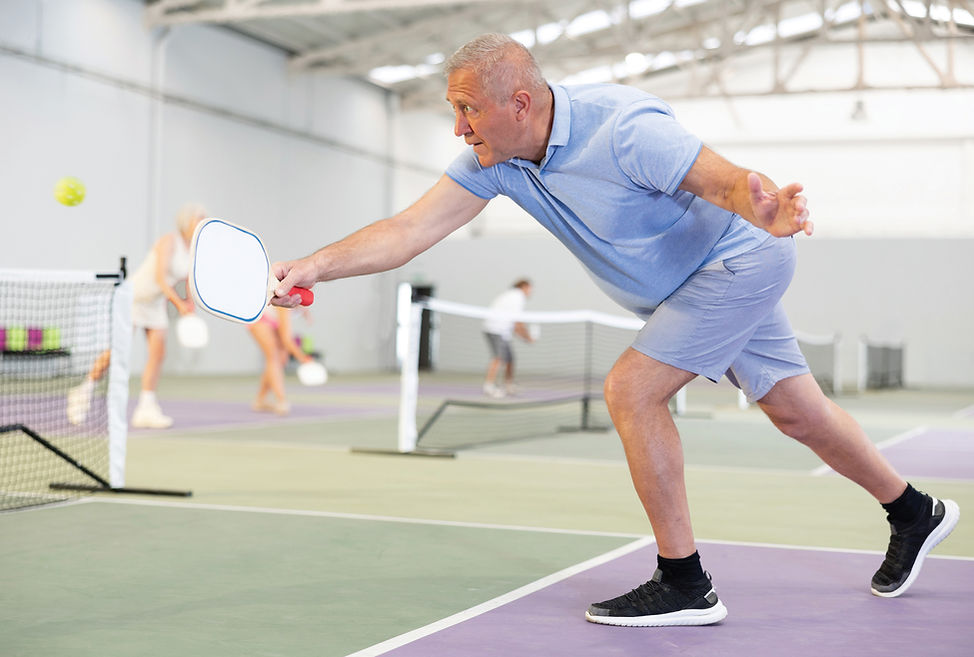September 10, 2024
Reducing Injuries with Positioning!
By Noe Sariban, PT, DPT, Cert. DN, TPI MII, CPTP

It’s not every day a sport comes around that is so addictive that it pulls people off their couches and out of “sport hibernation.” Pickleball has certainly changed many lives in the past decade and has enabled people who may not have been as active as they once were get back into the competitive spirit and out on the courts.
Pickleball offers many health benefits as other sports do, but the difference with pickleball is that its low barrier of entry to the sport (easy to learn and have fun, relatively inexpensive) has attracted people from all walks of life: previous athletes, sedentary and out-of-shape people, older, younger, you name it! I have met a lot of people whose lives have improved, and overall health has improved, since starting pickleball. This is all great news!
The downside: People who may not be experienced or used to playing sports anymore are now out on the courts five, six, and even seven times a week, and this can lead to injuries. One of the biggest risk factors I see on the courts leading to potential injuries is improper positioning.
Why is positioning so important? Everything in pickleball is about positioning. The better your position is on the court, the more successful you will be at hitting the next shot. When positioning is not ideal, people resort to compensations (from a movement perspective) in order to contact the ball. These movement compensations place our bodies in—at times—awkward positions that can increase our injury risk.
Here is a concrete example:
You are at the kitchen line, and someone hits an angled dink that is outside of your comfortable reach (we’ll define comfortable reach as a ball within a wide base of support). You were late to notice that the ball would be outside of your comfortable reach, so now the ball has bounced and is moving away from you to the side. Since you had not moved your feet early enough, you now bend over and twist while reaching away from your body to contact the ball.
This is a common situation that occurs in pickleball (that does not occur in tennis, for example), as the nature of a dink is that the ball will be low. The combination of the reaching, bending and twisting can be a vulnerable position for the lower back (lumbar spine). This is only one example but it is a good representation of how poor positioning increases someone’s injury risk.
So, what can be done?
Working/drilling intently on your footwork is critical in developing proper motion around the court. There are four main steps used in pickleball to move effectively and efficiently. They are: sidestep, side shuffle, pivot step, and cross-over step.
Sidestep: Self-explanatory… From your athletic stance (wide base of support, chest leaning forward, buttocks back), take a step to the side. This allows your base of support to be wider and makes your comfortable hitting zone larger. You should use this step when the ball is hit slightly away from you.
Side shuffle: When the ball is hit a little farther to your side, using the side shuffle is the next step. This is the progression of the sidestep, and allows you to move laterally and relocate your hitting zone to match the location of the shot.
Pivot step: This is one of the most underutilized steps at the amateur level. Just as the name implies, the pivot step is like a basketball pivot. This should be used when the ball is going to land near the player’s foot. This is a ball that could maybe have been volleyed (hit out of the air), but possibly misjudged so that the ball would now land near your foot. It is imperative to move the targeted foot out of the way with a pivot step, in order to allow an alley for your shoulder to swing and enable you to be positioned behind the ball at contact.
Cross-over step: The final step is the cross-over step. This step can be considered an emergency step in some cases (also a higher-level step on the backhand side). When the ball is hit away from your body (strong angle), you may not have time to side shuffle or sidestep, and so utilizing the cross-over step is quicker and more efficient. The downside of this step is that your base of support will be narrower, making you less stable at the time of contact. Less-stable positions lead to more errors making shots, but the benefit gained by the efficiency of the movement can be worth it at times.
Utilizing proper footwork and movement prior to striking the ball is the key to getting your body positioned properly to hit the ball. Better positioning leads to your body not needing to compensate, which in turn leads to a lower risk of injury. A high-level, quality instructor should address your movement on the court to ensure that your positioning is optimal to reduce your injury risk.
If you’d like to learn more about this, you can contact The Pickleball Doctor at thepickleballdoctor@gmail.com. The Pickleball Doctor works with the sport’s No. 1 men’s player in the world, Ben Johns. •
Noe Sariban is a doctor of physical therapy and owner of Move It Physical Therapy in Chapel Hill, NC. He is a certified pickleball teaching professional through the IPTPA, an Engage sponsored athlete, and the Team Engage physical therapist. Visit thepickleballdoctor.com for more information on injury prevention and rehabilitation tips.

